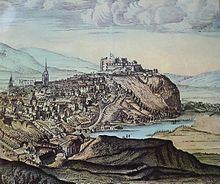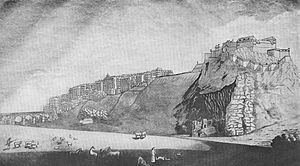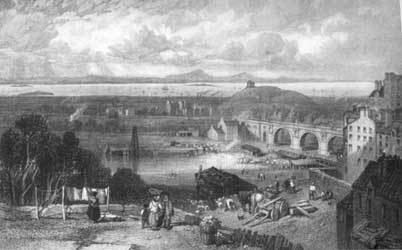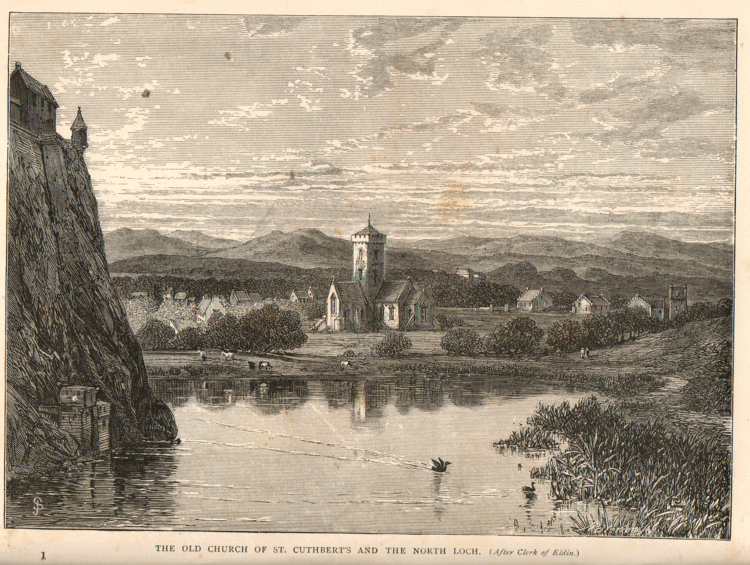The Nor Loch, also known as the Nor' Loch and the North Loch, was a loch formerly in Edinburgh, Scotland, in the area now occupied by Princes Street Gardens, which lies between the Royal Mile and Princes Street.
Contents
- Geological formation
- Early history
- Middle Ages to 19th century
- Modern period
- Other lost lochs in Edinburgh
- References

Geological formation

The depression, along with the parallel one, now occupied by the Cowgate, was formed by glacial erosion during the last Ice Age, when the icepack was forced to divide by the volcanic plug now known as Castle Rock.
Early history

The Nor Loch was initially a marsh, and part of the natural defence of the Edinburgh Old Town. Because the Old Town was built on a steep ridge (still clearly visible today), it expanded on an east-west axis, eastwards from the castle; expansion northward, as would happen with the later New Town, was extremely difficult at this point. The Nor Loch was thus a hindrance to both invaders and town growth.

In 1460 King James III ordered the hollow to be flooded in order to strengthen the castle's defences. The loch was formed by creating an earthen dam to block the progress of a stream that ran along the north side of the castle. The water level was controlled by sluice in the dam. It is thought never to have been particularly deep.

In the winter of 1571, the Earl of Morton suggested an English army would more easily capture the Castle from the north because the Loch would be frozen and there were no town walls on that side.

In 1603, King James VI gave the Town Council title to the land, pools and marshes of the loch.
Middle Ages to 19th century
As the Old Town became ever more crowded during the Middle Ages, the Nor Loch became similarly polluted, by sewage, household waste, and general detritus thrown down the hillside. Historians are divided on whether the loch was ever used for drinking water.
The Nor Loch fulfilled a variety of other roles during this period including:
In 1628, a man called Sinclair confessed to committing incest with his two sisters. All three were sentenced to death, but it was said that the clergy commuted the sentence on the younger sister. Sinclair and his older sister were placed in a large chest with holes drilled in it and thrown into the loch to drown. Two centuries later, in 1820, the chest was rediscovered by workmen digging a drain near the Wellhouse Tower of the Castle. James Skene of Rubislaw, who was present at the work in the gardens, reported that the skeleton of a tall man was found between those of two women. Later 19th-century accounts report only two skeletons being found in the chest.
In 1763 the eastern end of the Nor Loch was drained to allow construction of the North Bridge although frequent floods both then and now, threatened to "resurrect" it.
Draining of the western end was undertaken 1813 to 1820, under supervision by the engineer James Jardine to enable the creation of Princes Street Gardens. For several decades after draining of the Loch began, townspeople continued to refer to the area as the Nor Loch.
Modern period
Although the Nor Loch was filled in during the 19th century, neither its legacy nor its name are entirely forgotten. During the construction of Waverley Station and the railway lines through the area, a number of bones were uncovered.
Princes Street Gardens were created in the 1820s and now occupy much of the loch's former extent.
Other lost lochs in Edinburgh
The Nor Loch is not the only "lost loch" in the city. Another example is Gogarloch in the South Gyle area. Like the Nor Loch, this was mostly marshland, rather than a true loch. It was reclaimed for a park, housing and to build the railway to the Forth Bridge.
The Meadows, a large open park immediately to the south of the city centre, was once the Burgh Loch, occasionally referred to as the South Loch.
